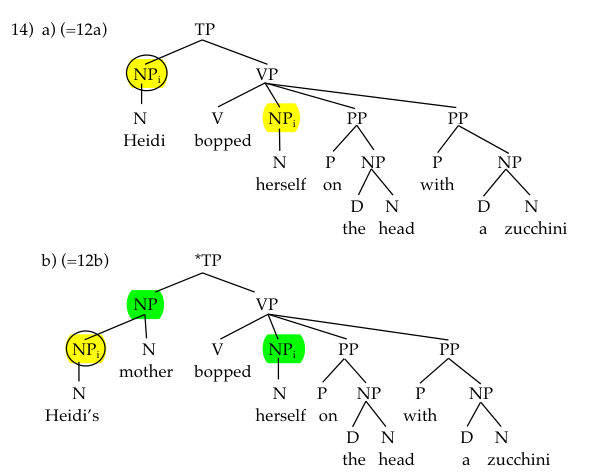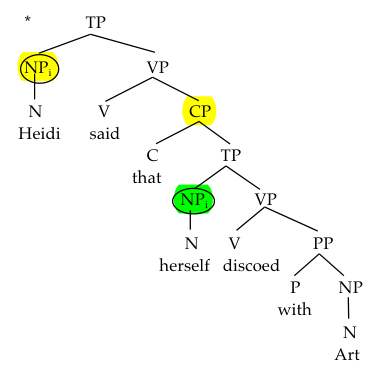Our current theory
We have PSRs in our head.
- They allow us to generate “grammatical” sentences.
- ungrammatical phrases are never generated
- psrs show constituency
- structural relations exist
So what generates these rules?
And can the justification for our theory make new and correct conclusions?
Dependencies as a syntactic phenomena
examples:
- It was a bagel that Zheng ate (gap)
- Filler gap dependency
- The key to the doors is missing
- Agreement dependency
- Jane had done the job herself.
- Reference dependency
Binding Theory
Binding Theory: Theory of the syntactic restrictions on which phrases of
the same class can appear in a sentence.
Example: R-expressions, Anaphors, Pronominals
- R-expressions: NP that derives its meaning from a subsistent entity in the world.
- Anaphor: NP that gets its meaning from referring to another NP in the sentence.
- Antecedent: NP that gives meaning to another NP.
- Anaphors must always have an antecedent in the same sentence
- Pronoun: NP that may or may not have an antecedent
- Refers to something in the context (indexical),
- But it may not have an antecedent in the sentence itself
- Pronouns and anaphors can also be antecedents
- Index: marker for labelling world references
[Heidi (antecedent)] bopped [herself (anaphor)] on [the head] with [a zucchini].
[Heidi]$_i$ bopped [herself]$_i$ on [the head]$_j$ with [a zucchini]$_k$.
Heidi and herself are coindexed $i$.
What is Binding
- [Heidi]$_j$ slapped [herself]$_j$.
- [Heidi_j’s mother]$_i$ slapped [herself]$_i$.
- *[Heidi_j’s mother]$_i$ slapped [herself]$_j$.

A binds B iff
- A c-commands B
- and A and B are coindexed.
Hence binding is coindexation when one NP c-commands the other.
Anaphors in binding
- [Herself]$_j$ slapped [Heidi]$_j$.
- *[Heidi_j’s mother]$_i$ slapped [herself]$_j$.
Hypothesis 1.0: An anaphor must be bound by an antecedent R-expression.
Important: The binder (antecedent) must c-command the bindee (anaphor/pronominal).
Locality Conditions
*[Heidi]$_i$ said [that [herself]$_i$ discoed with Art].

The anaphor seems to need to find its antecedent in the same clause.
This is called a locality constraint.
Locality constraint: A certain rule must be satisfied within a certain locality.
Binding domain (ver. 1): The clause containing the NP
Hypothesis 2.0 (Principle A): An anaphor must be bound by an antecedent R-expression in its binding domain.
Alt hypothesis: An anaphor must be c-commanded by its antecedent without any other R-expression in between
- Structural Relation
- Locality Restriction
Distribution: Free vs Bound
- [Heidi]$_i$ said that [she]$_i$ discoed with Art.
- [Heidi]$_i$ said that [she]$_k$ discoed with Art.
- [Heidi]$_i$ played with [herself]$_i$.
- [Heidi]$_i$ played with [her]$_j$.
- *[Heidi]$_i$ played with [her]$_i$.
- 1 and 2 show that pronouns can be unbound, or bound to antecedent.
- 2 and 5 show that pronouns can only be bound to antecedent outside of the binding domain of the pronoun.
- Unbound NPs are free.
- 3 and 4 demonstrate grammatical uses of anaphors and pronouns within the binding domain.
Principle B: A pronouns must not be bound to an antecedent (i.e. free) in its binding domain.
The distribution of pronouns and anaphors are mutually exclusive.
- [Oliver]$_i$ beheaded [George]$_i$
What about identity statements (“A is B”)?
Principle C: R-expression must be free.
Is binding principle universal
- No across languages (try w. others)
- No within English?
- While he$_i$ was overseas, Zheng$_i$ fell down.
X-bar Theory
- X-bar theory
- X-bar theory pt 2
Summary
Motivation: Replacement test in the following sentence:
I bought [the big [book] [of poems] [with [the blue cover]]] and not the small [one].
I bought [the big [book] [of poems] [with [the blue cover]]] and not the small [one] with the red cover.
Why is a collection of sister constituents of the NP replaceable with one?
Why is this applicable on several levels?
Ans proposed: embedded structure.
Theory statements
- all phrases must have heads (endocentricity)
- anything in an X-bar rule that isn’t a head must be an optional phrase
- Head introduction Rule (The termination rule)
- Recursive X’ Rule
- Specifier rule
- XP $\rightarrow$ X’ (ZP)
- How to motivate the existence of ZP?
- We can imagine languages with many determiners! Why all langs we see only have one? (falsifiable by counterex!!)
- i.e. why do we remove the XP from X’?
- How to draw the tree?
- proform replacement:
- “one” (within NP)
- “do so” (within VP)
- “so”/”that way” (within AdjP, AdvP, PP)
- Conjunction on X’
Adjunct YP: Sister to some X’ and daughter of another X’
Complement YP: Sister to the head X and daughter of another X’
How to determine complements (data required):
- Is the YP’s sibling replaceable?
- the book of poems
- vs *the *one of poems
- book must be an X instead of X’
- Can the YP’s sibling X be replaced by another X’?
- One way to test: can we insert in another one of the YPs?
- the book of poems
- vs *the [book of fiction] of poems
Distinguishing specifiers, complements and adjuncts
- Only one specifier, must be on the outermost level
- Complement can only appear next to the head
- You can only conjoin a complement with complement, adjunct with adjunct, but not complement with adjunct
- One-replacement will not work on N (*the one of X)
- Do-so replacement will not work on V (*W ate a bagel and X do so a banana)
X-bar usage: Justifying word order variations
\[\]
Problems:
- How to generate VSO? S will be intervening the VP containing V and O.
- In some sentences there can be several word orders for different XP types.
- German: $T’ \rightarrow T \ VP; \ V’ \rightarrow NP \ V$.
Housekeeping
- Projections of the head X:
- ancestor X’ (intermediate projections)
- XP (maximal projection).
- Principle of Modification:
- if a YP modifies X, then it must be dominated by some projection of X.
- Direct Object:
- NP/CP that is complement of V
- Word order:
- the complements/adjuncts may appear before or after the head depending on the language
- Language parameterization


